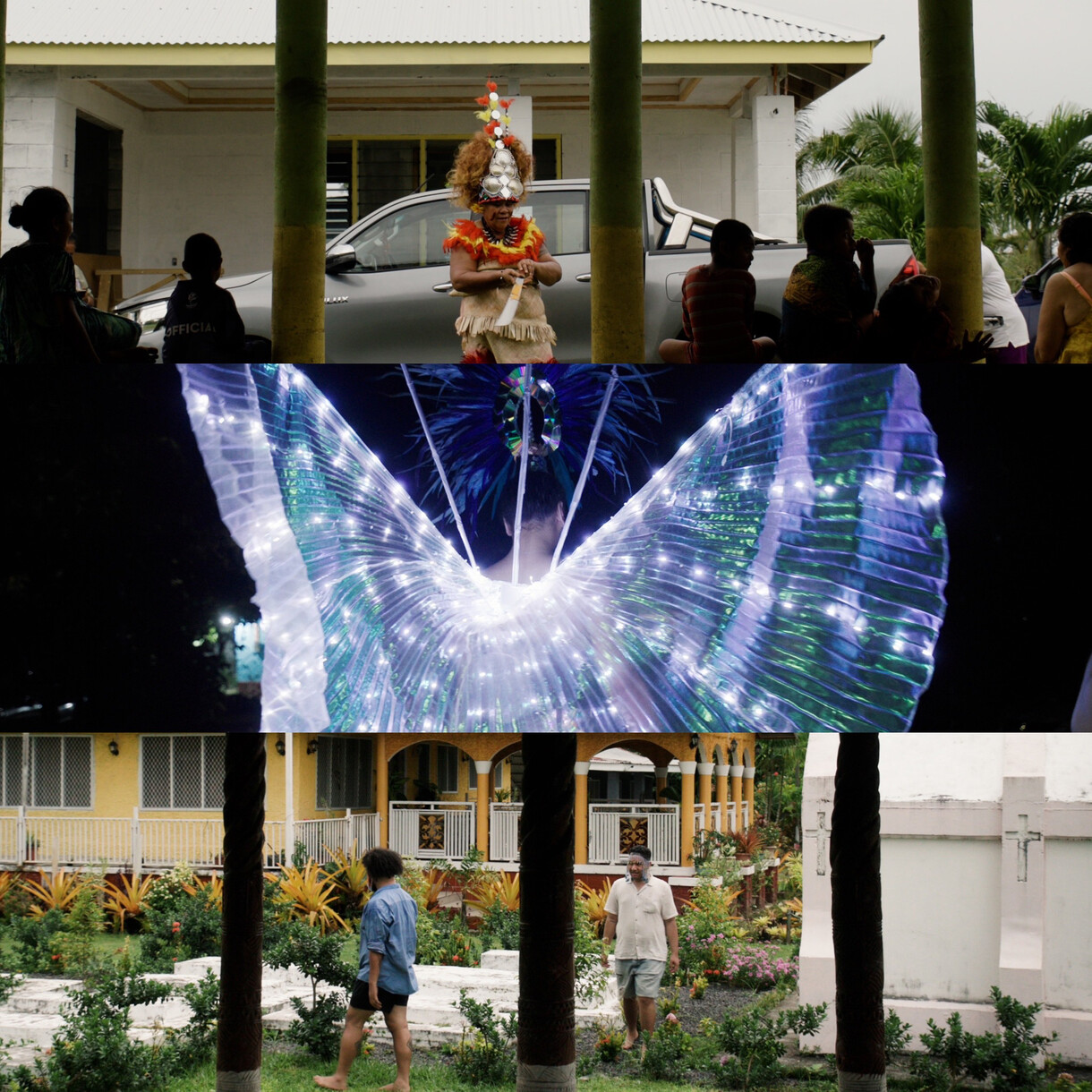Toloa Tales
Conversations with Edith Amituanai and Sione Tuívailala Monū
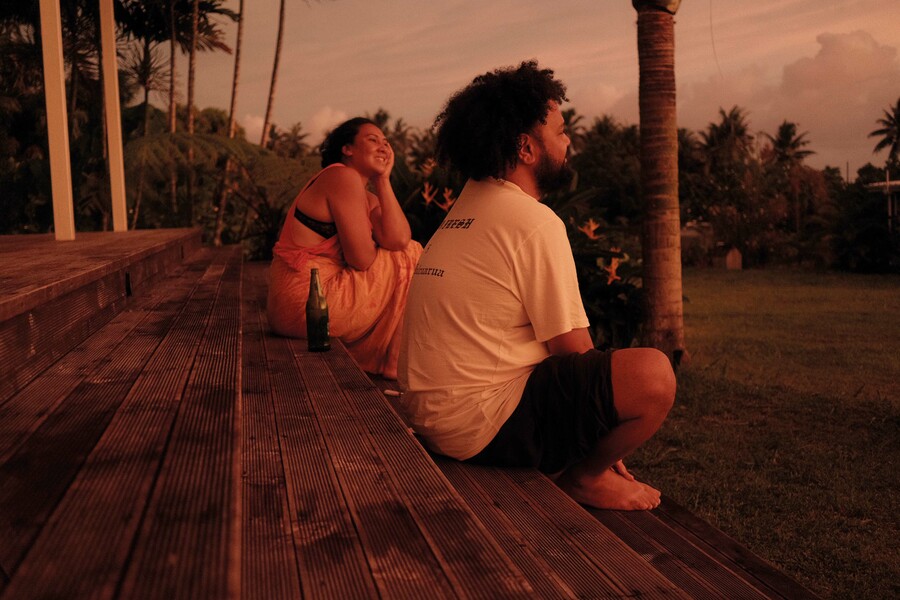
Edith and Sione after a day’s shoot, Siumu, 2023
In November and December 2023, artists and friends Sione Tuívailala Monū (Aotearoa, Australia, Tonga) and Edith Amituanai (Aotearoa, Sāmoa) went to Sāmoa together to make new video works for their forthcoming exhibition at Christchurch Art Gallery Te Puna o Waiwhetū: Toloa Tales. With extended family and now her mother and aunt living there, Edith has visited several times before. However, this was the first time for Sione. The relationship between Tonga and Sāmoa is one of ancient rivalry and connection, with Tonga more recently exerting colonial force in the region before European and American colonisation. Edith and Sione talked to Bulletin about their time in Sāmoa, their process of making, and how their understandings of cultural identity and migration have changed over time.
Can you talk about the idea of motherland or an ancestral land, and how that might be thought about by Pacific peoples in Aotearoa and in the Pacific?
Edith Amituanai: It’s kind of hip to be romantic about your ancestral homeland isn’t it? There were times in Sāmoa, drinking Taula beers, when I also thought about it in that romantic way. But when we were there and working, it wasn’t such a big deal. So I think that’s funny. Our relationship to place is more fluid – you come and go and it’s your relationship that changes.
Sione Tuívailala Monū: I think growing up my parents and their parents were quite staunch about our culture, our homeland and the practices that they maintained as Tongans. I get that, because they’re trying to keep those practices alive while outside of their homeland.
But we had some family come from Tonga for my auntie’s funeral recently, and they were saying we don’t do funerals like this anymore in the islands. We don’t extend it for this long like we all grew up doing; we have the ceremony and burial the next day. It was funny because the New Zealand Tongans and Australian Tongans agreed, but they still do it that old way. I found it really cool that in the islands, they’re less staunch. They’re open to change out there – things that make it easier for them – and I totally understand why. In the diaspora, they’re clutching at something they don’t want to lose.
Edith: They’re holding on to their version of the culture that they arrived with. I understand that.
Sione: I guess our relationship to that culture does change as we get older, and we have to decide what it is to us now and how we want to continue forward.
Edith: Because when you’re little you don’t have control over it. It’s something that you’re raised in and shown. And as you get older, you have to figure it out for yourself – figure out what it means to you.
Sione: I also find it interesting to think about what our relationship to the Pacific was like growing up. Because it sounds like we both had a strong upbringing within our culture. And I find with artists specifically, that as they get older they question more how they want to take it forward. I relate more to the way homeland Tongans are more flexible with the culture. I think artists are always just naturally challenging things.
Edith: Our relationship to the Pacific is complicated, isn’t it? When you’re younger, you’re in it, right? If you get the opportunity you can try to push back, but you are in it. I remember it feeling suffocating when I was a teenager – why can’t I drink with my fifteen-year-old friends? Which is not really cultural. But you don’t understand that and you think that some of the things you’re inheriting are cultural but they’re not. So I think it’s more relaxed than I thought. Although I am guilty of romanticising it, too.
Sione: Well, our parents were completely romantic about island life I think, or at least mine were. They framed it in that way, I guess, because they grew up there, and then they came here. The islands changed but they’d left.
Edith: Yeah, so we get the 1980s version via Tonga via Australia.
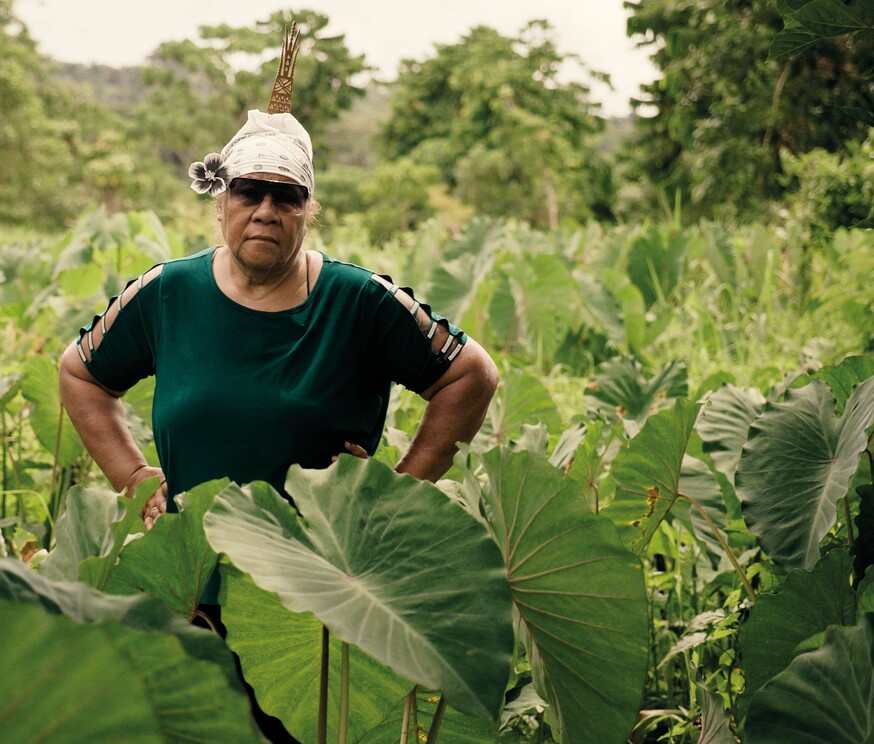
Edith Amituanai Vaimoe (still) 2024. High definition video. Courtesy of the artist
Why did you decide to travel to Sāmoa and make new works?
Sione: We had been in conversation about dream projects and films we would make in the islands one day, and then the opportunity presented itself when the Gallery commissioned this project. So we put together this trip to make something. We had a friend competing in the 2023 Miss Sāmoa Fa‘afafine Pageant and we wanted to support them and make work around that. But Edith when did you start this idea of filming your auntie? When did you think of that? Because she moved back there quite recently, right?
Edith: A film gives you a lot of motivation – you get a team with you and that allows you to do a bigger project. And it’s always good to work with what you have, so I thought, oh, who best to make a project about… I really like people that want the limelight. It makes it easier. And my auntie said, “I’m not going to miss out, it’s the opportunity of a lifetime!” So that’s an easy decision. What about you?
Sione: I’ve always wanted to visit Sāmoa because my family has connections there way back. I had built this romantic image of going back and connecting to my ancestors, my homeland. And I was very curious to see Sāmoa compared to Tonga, because I’ve visited Tonga a few times to make art. I had a feeling it wouldn’t live up to the ideas in my head, but luckily it was way more than that! Also, I wanted to make a bigger moving- image work – I’ve always just worked on my phone and this was my chance to work with a team. Yeah, big equipment to prove to myself that I can do it.
Edith: It’s fun to make work like that. Oh, can I do it? Let’s see, can I upscale this thing? Can we do it in international waters? I think it’s fun. It’s also a pretty amazing thing to be able to do as an artist. That’s our job – to go to Sāmoa and work for five weeks! I have been a couple of times for jobs but not for this long. And not where I had the lead. So it was amazing to work with my family and wider community on a project like that. That was pretty wild and a huge privilege.
Sione: We also caught the Fa‘afafine pageant with Samora Kake. That was great to see some locals or some of our people from Aotearoa in the islands. Some of our friends had a really beautiful, emotional time there. Reconnecting. That was sort of what I had romanticised in my head that I would experience, so it was a privilege to get to see them have that connection of being back in their homeland.
Edith: I don’t think I’m wired that way. But I think the feeling of working there with your friends and your family might be the same kind of thing?
Sione: Yeah, I definitely appreciated that. Making that connection to the land in that way. And I’m also a Capricorn, so I like working. I realised even if I was in super beautiful islands, I wouldn’t have enjoyed it if I wasn’t making something. What about your auntie? Why did she move back to Sāmoa and what do you think returning after so long was like for her?
Edith: I think that you get to a certain age and the call to return home gets louder and stronger. I also think that that conversation was started by my mum when she visited a few years ago and encouraged her to think about moving back to Sāmoa. You can reinvent yourself back in your homeland in a way that is harder to do in America or New Zealand. So it’s another phase of her life, a reinvention, a homecoming, but also she’s more redemptive in this later stage of life. If I had filmed her when she was younger, in America, it would be a completely different film. I guess I’m getting her on her wiser contemplative return, but I think it is also an excuse to do something that looks at the idea of people returning home, because many Sāmoans want to do that – whether they’ve lived there before or not. The idea of buying another house in Sāmoa is a very current topic now. So yeah, I maybe used her as an excuse to explore this idea of home too. How did it feel for you visiting Sāmoa for the first time?
Sione: It was beautiful. I was comparing it to Tonga a lot when I was there. But it’s just so different. And I found it interesting. A lot of people there know about Tonga’s history of colonisation and when they found out I was Tongan they would say “Oh, Tonga, yeah yous used to rule here. We used to be slaves to you”, and they said it so nonchalantly. And that was surprising – it is obviously traumatic history, but the way they presented that history to me wasn’t with any trauma. It was a joke.
Edith: But here I’ve seen, myself included, we’ll fight people for making fun of us. If Tongan’s are like “Haha we used to rule you” we get really upset about it. But Tonga’s rule is very much a part of Sāmoa’s story, it’s a part of our history. There’s an acceptance. It’s not like a disconnection between the cultures.
Sione: Is that time do you think? Because, I imagine, the more recent colonisation history is fresher in the minds of Sāmoans and the trauma of it is more evident. But it’s almost like Tonga’s colonisation isn’t on that level anymore, it’s history...
Edith: It’s just that “Oh yeah the Tongans did rule here and their islands aren’t that far away. They used to come around here quite often.” So yeah, I think it’s like the neighbours or something. Cousins.
Sione: I found the homes, the structures in Sāmoa, so Pacific Island coded, in that you kept a lot of your structures from pre-colonial times. And in Tonga it’s nothing like that – we don’t have any Indigenous structures. We got rid of them. Even tatau.

Edith Amituanai Vaimoe (still) 2024. High definition video. Courtesy of the artist
Did your perspective change from the visit and spending time there? When was the last time you had visited before this trip?
Edith: I think I went three times last year – I was also there in March and then again in May. May was for a cousin’s wedding and I photographed that. And March was a saofa‘i, and I photographed that too. I think the camera offers incredible access that you don’t get when you don’t have a camera. People thought I was media or working for the New Zealand Government when I showed up.
Sione: Oh, and they thought we were the university.
Edith: I guess that’s who they understood that we were funded by. It was very beautiful the way we were treated – they really took our project seriously. It made me want to work there again. What about you?
Sione: It was so smooth. And being privy to your connections, your family, getting the special treatment. That was really nice.
Edith: Nice being fanned when you eat...
Sione: Oh my gosh. We don’t go that far in Tonga. But, we should...
How do the scenes differ from Aotearoa for both contemporary art and queer culture?
Sione: I didn’t really get to explore the scene there as much as I would have liked. But the pageant was amazing. I saw the Fa‘afafine Foundation, and the previous prime minister made a speech.
Edith: Yeah, he sounded like a good ally. What he was saying, his speech was good. But that could have been a whole other film, just focusing on the pageant and all of that. How did you manage to negotiate what to include from it in your film?
Sione: Well, I was lucky to have Samora and Cameron [Ah Loo-Matamua] and the Aotearoa team they had with them there to work with, and I got to shoot Cameron’s village which was beautiful, and them in the fale. If we had longer I would have preferred to connect with the local scene, but I had to decide that it was very much just shooting me and my experience of the island. But it would have been cool to work with more of the locals.
Edith: You’ll have to go back again.
Sione: What did your friends and family think about the work you were making?
Edith: I get the same reaction, whether I’m filming or photographing here or anywhere. It’s kind of like, sort of interested? They don’t really understand it. It can be exciting – someone coming to town to photograph you, but also uncomfortable. Someone filming you while you’re eating crab? I guess they’re a bit puzzled: why do you want to come film us collecting seafood? But I don’t mind that, because it’s hard to explain when you don’t know what you’re doing either. We’re just going to have to go back and show them what we did. That’d be so fun! What did your friends or family think about you going to Sāmoa as a Tongan?
Sione: They were surprised! Yeah, they didn’t really understand. The older family thought it was funny, but I guess my immediate family know me and the kind of art I make and they were curious. Sāmoa is not a subject my family really deep dive into. So I guess I was curious and wanted to see why.
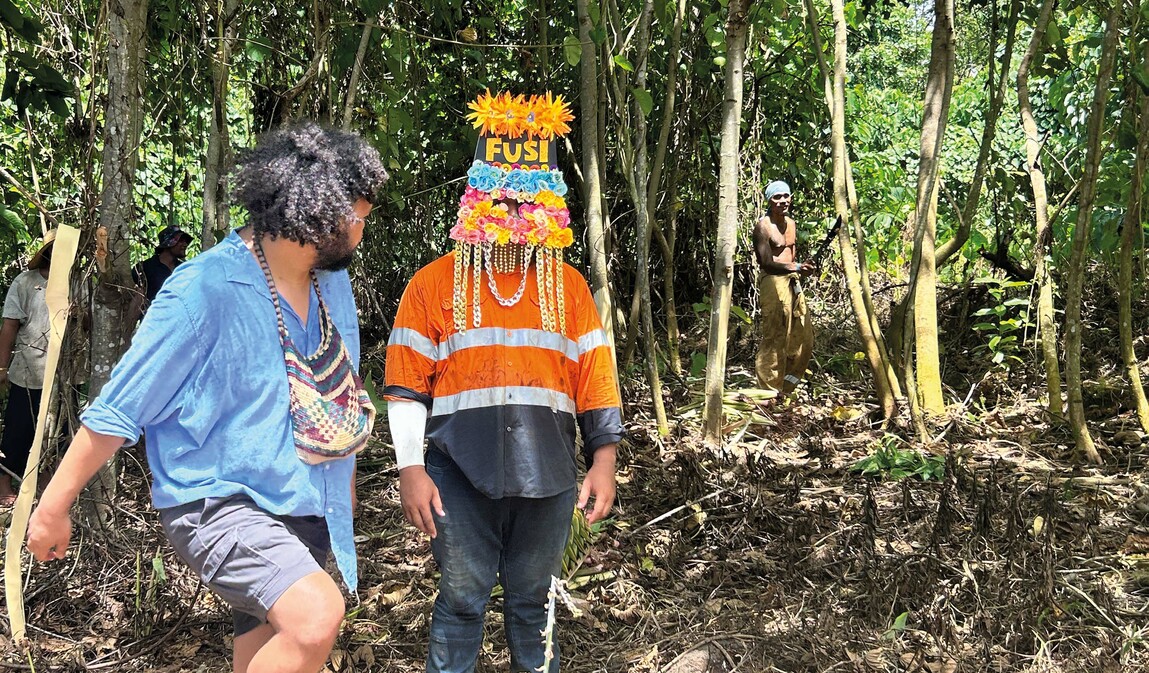
Sione at work, Samoa, 2023
How does your film practice differ from your photographic practice? Are there things you can do through film that you can’t do with photography?
Edith: When I photograph, I think in single images. I’m trying to sum everything up in a single frame, which I think is closer to a painting, or what I think about painting. It’s more constructive, I suppose, in my mind. I’m looking for the perfect frame. But in filmmaking, perhaps I’m thinking more sequentially, and I’ve had to let go of some of those ideas of perfect frames. To allow the camera to be a bit loose. Not that I love a shaky camera, but I allow the camera to move in a way that I don’t with photography. If every scene that you have is painted as a kind of Sistine Chapel in your mind it can be overwhelming as a sequence because you do need some quieter moments. Whereas I don’t like that in photography, I’m a bit more ruthless, because you’re only going for one printed image.
Sione: And I guess the film is more the relationship of images to each other.
Edith: Yeah. And you’re thinking about where it goes in an order, what you’re working up to. Someone said to me, “Oh yeah, I can tell their filmmaking practice is like this. They film something from one angle and then they’ll do it again from another angle, and then they’ll do the same thing from a different angle or perspective.” And that made me recoil. I was like, urgh, I don’t like that. I don’t know why, but I still think in a kind of one frame. The camera is like this. Often it doesn’t move.
Sione: Well, I guess film is milking the theme as much as you can for the edit.
Edith: What about your editing process – how do you develop a narrative in your work?
Sione: I think my process is quite loose. I have ideas around character and world, and then I have scenes in my head. But the edit is king for me. I love finding the narrative in the edit, and it’s all about getting as much of the character narrative as I have, maybe not complete when we’re filming, but getting as much of the idea shot as possible. And then in the edit I find that narrative. That’s more my practice, even with my phone, and I wasn’t sure if it would translate to film, which is more like a big production. But I did stick to that process while we were filming and I’m figuring it out now in the edit. I haven’t finished the edit yet.
Edith: But you’re still finding something?
Sione: Still finding. I’ve got scenes and sequences down and I like the narrative of it at this stage. I haven’t figured out the full film narrative yet. And we still need to shoot some stuff here. But my favourite part is connecting all the imagery in the editing process.
This is an edited version of a conversation recorded by Sione and Edith in March 2024.
Fa‘afaftne – people who identify themselves as having a third gender or non-binary role in Sāmoa
Fale – house
Saofa‘i – the formal acceptance of a new matai or chief by their family and village
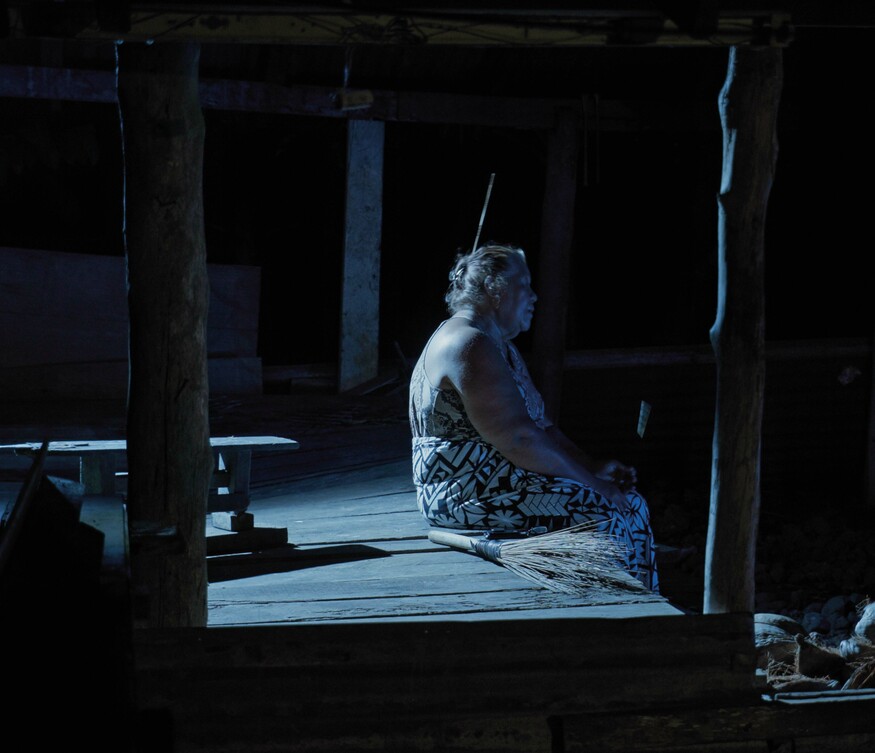
Edith Amituanai Vaimoe (still) 2024. High definition video. Courtesy of the artist








